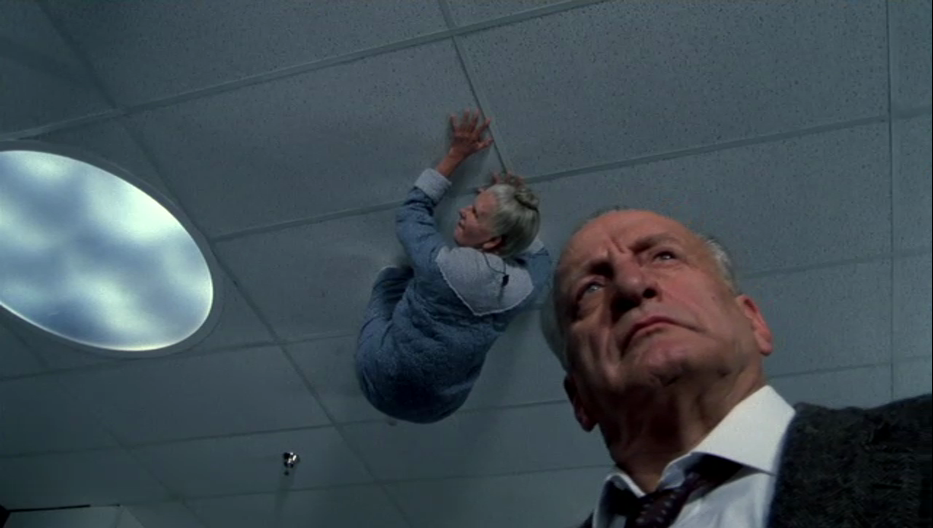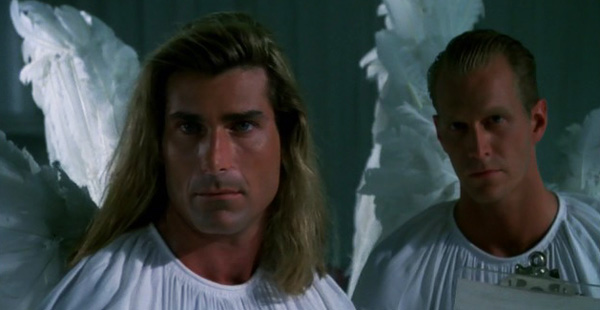
Rodan hits the Terrible Twos in almost no time.
This January, in support of the Toronto Rape Crisis Centre / Multicultural Women Against Rape, friends and family have raised over $1,000, which means I have to watch and write about thirty-one horror movies. I’ll watch (on average) one movie a night, many of them requested by donors, after which I’ll write some things about said movies on this website. Be forewarned that all such write-ups will contain spoilers! Today’s film is a request from my very own mom, Japanese monster movie, Rodan, directed by Ishiro Honda (Godzilla, Mothra)! Rodan is one of my mother’s all-time favourite movies from her youth, during which she spent much of her time in movie theatres. Without a doubt it’s her favourite Kaiju movie – that is, the genre of Japanese disaster movie featuring giant monsters laying siege to a city or two. (The most famous of which is Godzilla.) I rented Rodan from my friends at Queen Video.
What happens:
Rodan opens with a prelude about atomic weapons. Over several minutes of stock footage of atomic bomb testing, a narrator outlines how the American military tests new weapons of distraction, including the hydrogen bomb, in and around the Pacific Ocean. As his monologue progresses, he becomes more and more dramatic, his prose more purple. At one point the shockwave caused by an atomic bomb is described as “some gigantic and murderous hammer” – which: fair enough. The narrator wonders what the aftermath of all this atomic testing might be, then invites us to watch the story of one such aftermath.
The action of the film begins in the mining village of Kitamatsu, located on the far-southern Japanese island of Kyushu. Our narrator and protagonist is Shigeru Kawamura (Kenji Sahara), a safety engineer for the village’s coal mine. Even before anything goes wrong, Shigeru worries about the number 8 mine, which he notes is far deeper than any of the other mines. Already they have noticed “creeping floor” in that mine, whatever that means. In no time, he receives a call about flooding in that very same Shaft 8. Shigeru leaves to investigate.
He arrives at Shaft 8 to learn two of the miners – Goro and Yoshi – have gone missing. They were seen fighting earlier in the day and no one knows where they are. This is a problem – and not just for safety reasons. Shigeru is to be wedded to Kiyo, Goro’s sister. Shigeru leads a group into the flooded shaft, and they soon find Yoshi face down in the floodwater. But he didn’t drown; instead, he was sliced to pieces. Immediately suspicion turns to Goro (as they hadn’t been getting along). Shigeru tries to shut down that gossip, though. After all, Goro’s sister is his fiancee.
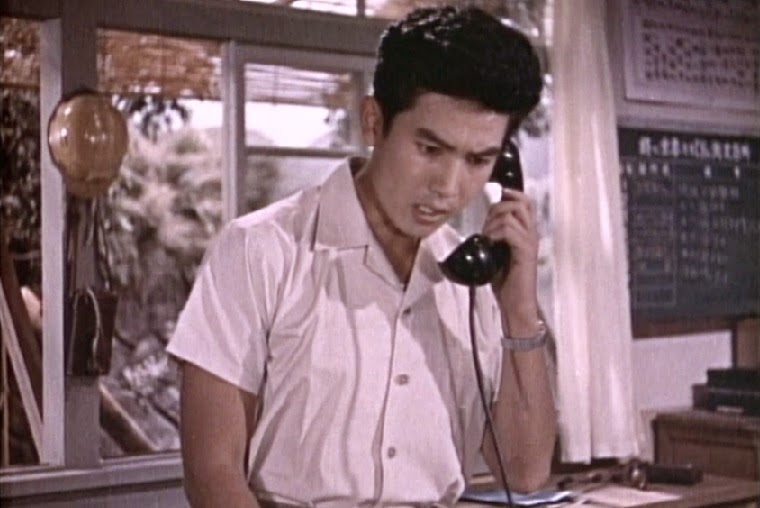
Our creeping floor issue has just got a lot worse.
Speaking of Goro’s sister, Kiyo (Yumi Shirakawa) meets Shigeru on his way home from the mine. He has to regretfully inform her that Goro is still missing. But he assures her that Goro didn’t kill Yoshi; he’s almost positive of that. The police join the search for Goro, now that this has become a murder investigation. An officer goes with two miners back into Shaft 8. They tie themselves together with a strong rope and wade into the floodwaters. The first two are quickly attacked, Jaws-style from below, and the third runs to the mine elevator to escape. He sees massive shadows playing on the walls and hears weird sounds reverberating through the mine. Before the elevator arrives, he is attacked by a massive unseen thing. The three men’s bodies are retrieved and Dr. Minakami (Kiyoshi Takagi), reporting to the interested parties, says their bodies have been torn apart, but he doesn’t want to disseminate this information as it would spread panic throughout Kitamatsu. Little does he realize the panic’s about to spread through Kitamatsu with little assistance from him.
Shigeru visits the grief-stricken Kiyo. He (strangely) suggests she leave town for a little while and things will seem better. As he comforts her, an insect the size of a bear lumbers up to the open side of her house. The couple flees and calls for the police immediately. The police confront the giant bug, but are little match for it. Not dicking around in the least the police chief calls for the military immediately. Then the police and seemingly every able-bodied man in the village chases the giant insect up the nearby Mt. Toya and unload their guns. The insect bites into two of the men, killing them, then flees. Dr. Minakami, probably the smartest man in the universe, studies the freshly dead men’s bodies and notes the wounds are the same as with the earlier victims. (Thanks, Doc.)
Shigeru, quite the reckless risk-taker for a safety engineer, announces he’s going to enter Shaft 8 to finally find Goro. The police chief offers a few of his men to go with him. Before they can even leave, the very efficient Japanese military arrives in record time. A bunch of the newly arrived troops join Shigeru, as well, and they travel underground in search of Goro. It doesn’t take them long to discover Goro’s dead body. And as soon as they do, the massive insect discovers them. The military uses a machine gun on it, and the bug still won’t stop. All the automatic weapon manages to do is to weaken the structural integrity of the mine. Shigeru has a better idea: he pushes a loaded coal cart downhill, and it races down its track, colliding with the bug and killing it. Shigeru then retrieves Goro’s body and the whole search party discovers there’s a second bug. The military again fires on the insect with a machine gun, causing a massive cave-in that traps Shigeru on the wrong side of a rock wall.
Topside the next day, a number of doctors and journalists, presided over by Professor Kashiwagi (Akihiko Hirata), wonder about rescue efforts for poor Shigeru. They don’t wonder long before an earthquake hits. The professor immediately calls the earthquake institute (as we all would) and asks the professor there about whether the quake will affect volcanic activity at Mt. Toya. They make a plan to meet at the epicentre of the quake to investigate and discuss. When they arrive, they find an injured man crawling amidst the rock rubble: it’s Shigeru!
However, Shigeru’s experience has left him with amnesia. He doesn’t remember his fiancee Kiyo, he doesn’t even remember his own name. While Kiyo waits patiently at Shigeru’s hospital bedside, the science team learns things about these giant bugs. Turns out the massive insects are actually prehistoric insects who must have remained hidden for centuries – millennia, even. Professor Kashiwagi brings the convalescent Shigeru some photos of the monster insects in an attempt to jog his memory: “I know you don’t remember the woman you love, but maybe you remember these insect monsters?” The photographs do cause Shigeru some mental distress, but he doesn’t remember anything new.
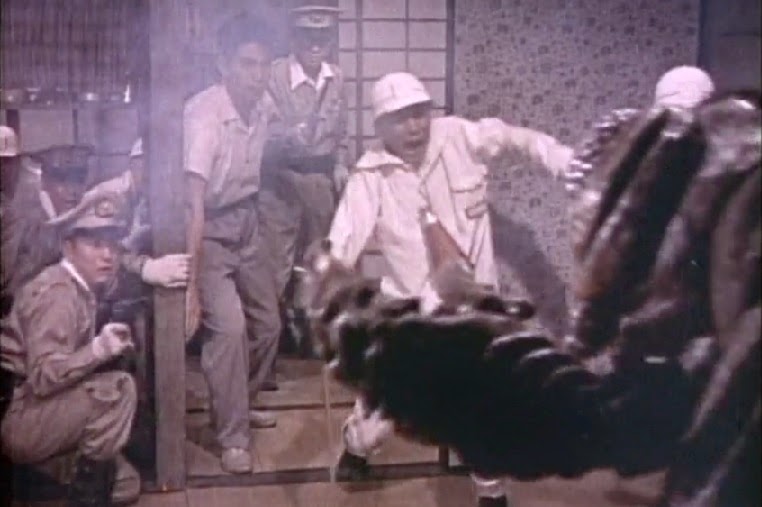
Can you believe someone would want to eat these guys? (I’ll let you decide if I’m talking about the miners or the insects.)
Elsewhere on Kyushu, an air base receives a transmission from a Japanese pilot: he reports an unidentified flying object moving at supersonic speeds with maneuvers and heights that seem impossible. The last thing the pilot sees before his jet is smashed to smithereens is the silhouette of a giant flying creature. In a military board room, the top air force brass look sternly at the pilot’s bloody helmet and clothes and wonder how such an aircraft would be possible: the pilot even said it reversed at supersonic speed.
Further reports of the UFO and its effects come in from around the region. A British cargo ship in the Pacific is destroyed, villages are levelled by the supersonic wake it creates. Tokyo suspends all air travel while something airborne (but, as of yet, unseen) terrorizes the entire South Pacific. Back in Kitamatsu, a young honeymooning couple go for a drive up Mt. Toya. The woman poses for a photo opportunity in front of the volcano. As her husband takes a few snapshots, she turns and is horrified by what she sees. She screams and something – the UFO, probably – carries the both of them away, leaving only a shoe and the broken camera behind.
Cattle have been reported missing from the area, too. The science strike team develops the couple’s photos and see the edge of the UFO, captured in their last photograph. “Is it a bird? Is it a plane?” is more or less their conversation. Back in Shigeru’s hospital room, Kiyo continues to care for the amnesiac fiancé. She takes the nest from their pet bird’s cage and shows him the two eggs. As Shigeru watches the eggs hatch, it induces a nightmarish memory from his recent past. In his flashback, Shigeru is laying injured in a cavern filled with massive prehistoric bugs and one titanic egg. The egg hatches and a massive creature that looks like a pterodactyl emerges. If you thought those prehistoric insects were large, wait until you see this thing! It eats those bugs for breakfast. Literally. And when it roars, it kind of sounds like a jaguar.
Back in the present, Shigeru is sweating profusely and flailing like one of those wind sock people at a used car lot. He calls out for Kiyo (remembering her name) and warns her that there are monsters afoot. (But on the plus side, his memory is back.) Shigeru promptly meets with a sketch artist to describe the monster in the cavern and the resulting illustration looks almost identical to a pterodactyl. The whole assembled gang decide they should go to the cavern and destroy any other eggs that may be down there. (How they’re going to do that, when they couldn’t even kill the things these monsters eat, is not thoroughly discussed.) Then begins a Descent-esque journey deeper and deeper into the caverns of Shaft 8.
Shigeru leads the crew to the spot where he saw the monster and they find some egg shell buried among the rocks. At first, they don’t notice it, as this egg shell is thick as a brick wall. A sudden cave-in forces them to leave quickly without further investigating the area. The scientists do an analysis of the egg shell and determine the following things: (a) it’s an egg, (b) it’s reptilian, and (c) it’s really, really big. They theorize the creature that hatched from the egg has a wingspan of 500 feet, capable of causing typhoon-level shockwaves. And it appears similar to a pteranadon (not pterodactyl – I was close!), though its species is Rodan. (What? How would they know that?) Professor Kashiwagi suggests that the egg had been hermetically sealed and recent coal mining broke said seal. However, all the military wants to know is where they can find this monster so they can kill it. The professor suggests a route.
A quick helicopter search finds a crater that Rodan (as they’re now calling the monster) makes home, if the scattered human bones are any indication. (Man, that professor is good!) Jets are scrambled and they open fire on the lair, but it just makes Rodan angry. Or rather, it makes the Rodans angry: they soon discover there are two of them: Rodan and his/her mate! They’re a power couple! A jeep of military troops drives away from Rodan’s lair but the sonic boom of Rodan’s flight sends the jeep flying into a cliff wall, turning it into a twisted heap of metal. The air raid siren goes off and a state of emergency is declared.
A long, drawn-out aerial dog fight follows, with the two Rodans taking on the Japanese Self-Defence Force (JASDF). One Rodan nosedives into a river, causing a tidal wave on a nearby shore. It flies over a bridge as it emerges, and just the force of its wings causes the bridge to topple. (It’s a good thing they just evacuated that bridge minutes earlier.) Rodan moves on to a Kyushu city and begins to rock it like a hurricane, causing destruction with the beating of its wings. The military calls in the tanks (which look faker than Rodan by a large margin), and they begin to unload a lot of firepower on the flying monster. They call Tokyo for reinforcements. The second Rodan joins the party and the two fly off, leaving the city in flames and hundreds dead.
Days pass with no Rodan sightings. So where did the Rodans go? Professor Kashiwagi has a theory: like other reptiles, the Rodans may have gone into hibernation. A plan is devised to kill the Rodans while they’re sleeping: they can blast their lair with missiles and bury them alive! The guy from the earthquake institute doesn’t love this plan; after all, they could kill the Rodans, but this plan would also cause Mt. Toya to erupt. Despite his misgivings, Operation Rodan is soon underway and Kitamatsu is evacuated.
The only person who hasn’t evacuated Kitamatsu, it appears, is Kiyo, who walks up to the military base where Shigeru and the team behind Operation Rodan are situated. Shigeru asks why Kiyo hasn’t evacuated yet and she tells him she wanted to be with him instead. Isn’t that adorable?
Following that scene of young romance, the entire Japanese military (basically) starts firing missiles into the crater that the Rodans call home. Several scenes of pure explosion pass. WIthout fail, the volcano erupts within minutes. One of the Rodans escapes its lair, only to be overcome by the toxic fumes of the volcano. It collapses into the lava stream and bursts into flame. The second Rodan emerges from the lair and, seeing its mate in the lava, joins it in death, willingly falling into the lava, as well. That’s true love. Shigeru, in a voice over, mentions how the monsters sink “against the earth like weary children,” then closes the film by expressing envy for the Rodans’ love for one another.
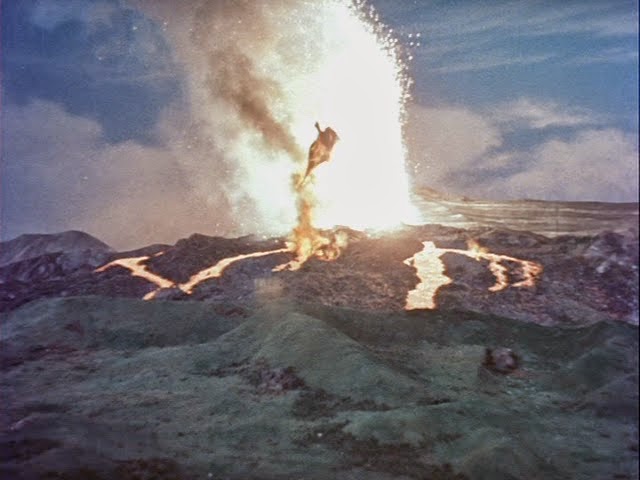
The Rodans meet their Romeo and Juliet ending.
Takeaway points:
- It’s a generally accepted premise that most Japanese monster movies developed from a (very understandable and real) fear of atomic testing. As the only country to have had an atomic bomb used against its populace, Japan would develop the films that most vividly and outrageously depict these fears. And the opening of Rodan reinforces that idea. There’s a whole speech about atomic weapons testing and the monsters it could create in its aftermath. But Rodan’s genesis has nothing to do with atomic testing. As clearly outlined in the movie, it’s mere Victorian-era-style coal mining that unleashes Rodan. “We had dug too deeply for coal,” Shigeru laments. So it seems bizarre to link Rodan to atomic testing in the introduction, as atomic power and weapons are never again mentioned. (Though as a side note, a case could be made for an interesting remake of Rodan that serves as a fracking critique.)
- When the air raid siren sounds in Rodan, I realized that air raid siren meant something very different in 1956 Japan than it did in the United States (or even modern-day Japan). This film was released only eleven years after one of the most heinous acts in history – the dropping of atomic bombs on Hiroshima and Nagasaki – killed over 200,000 civilians in Japan. Yet, here is a monster movie eleven years later, showing a monster laying waste to cities, primarily for entertainment purposes. Godzilla was released in 1954, just nine years after the atomic bombings. One can’t help but think about American film following 9-11 (which, for all its monstrosity, was a smaller tragedy in scale), and how distasteful viewers felt it was to show buildings being levelled in a disaster movie for years and years afterward. But it makes sense that filmmakers would want to depict simulacra of those disasters in film. There is, without a doubt, some cathartic element to the horror genre. Just as Stephen King dealt with his addictions though, say, writing Misery, I think it’s fair to suggest Japanese film culture (in general) dealt with the horror of nuclear holocaust with Godzilla, with Mothra, with Rodan. And the seemingly casual destruction of cities in these films is part of that process.
- Rodan was the first Japanese monster movie made in colour, and it looks pretty good. Common sense would suggest that black and white would hide some of the more janky aspects of the monster costumes worn in Kaiju movies, but Rodan looks good even in colour. In fact, there’s even kind of an eerie feeling when Rodan leaps and flies in slow-motion. The costume for Rodan looks so realistic (relatively speaking), that some of the models for the tanks and other military vehicles look embarrassing by comparison. (That kind of rhymes.)
- The surprise reveal in Rodan is that there’s not just one Rodan. There are two. This is a Scream-level twist. And Professor Kashiwagi suggests that they are mates. So the love story of the two Rodans parallels the love story of Shigeru and Kiyo. (Witness Kiyo join Shigeru as some of the last people in Kitamatsu, ready to face certain death. The two Rodans are a version of them, if their species had not won the battle.) Additionally, given this romantic setup, the opportunities for Rodan erotic fan-fiction are limitless.
Truly terrifying or truly terrible?: Neither. Rodan is not a terrifying film. It’s unlikely that any child has ever had nightmares about Rodan. But it’s a pretty good film, too. Certainly one of the better Kaiju movies, as it includes a pretty effective-looking monster who manages to be somewhat complex. Or at least elicit some empathy.
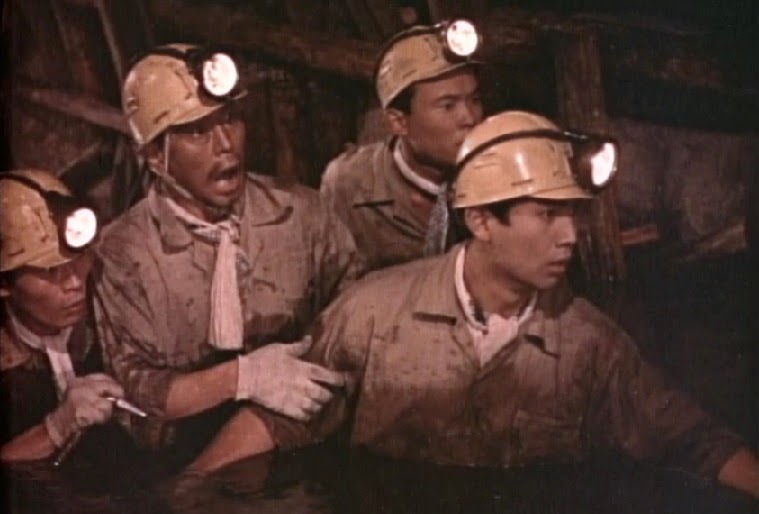
Trouble at the old mine in Rodan. But at least they’re leaving no smudgy fingerprints.
Best outfit: Give it up for Kiyo’s flower-patterned dress. I was also impressed by how the entire Japanese military wears white gloves, much like Bugs Bunny or Mickey Mouse. The mining staff, too. A routine internet search reveals that many Japanese professionals – particularly those in defence, policing, and driving – wear white gloves as a cultural norm. Pop-psychologists theorize that the use of the gloves subliminally reinforces the idea of maintaining propriety and encourages making the right actions. So I’m sure that principle was guiding the good men and women defending Kyushu from Rodan.
Best line: “Amnesia can be … difficult.’” – Dr. Minakami, demonstrating good bedside manner when he inform Kiyo her fiancee doesn’t remember who the hell she is
Best kill: Very few deaths in Rodan happen visibly, on screen. So maybe the bittersweet lovers’ suicide at the end of Rodan should take home the trophy.
Unexpected cameo: Maybe this is cheating, but in the English dubbed version of Rodan, the voice of Professor Kashiwagi is provided by none other than Twitter superstar and accomplished actor George Takei. Sulu himself! (He did a few other voices in the dub, as well.) Apparently, Rodan is one of the first movies where an actor of Japanese background did the voiceover for Japanese movie. Previously, Chinese-American actors had done the majority of the dubs for Japanese films. (And, indeed, some of the other voice actors in Rodan were of Chinese background.)
Unexpected lesson(s) learned: There’s a bathtub on site at every Japanese coal mine, just in case they need to clean up a miner’s corpse. (Unless they use it for other things? In this movie, that’s the only way that tub gets used.)
Most suitable band name derived from the movie: Shaft 8 seems the obvious choice. But let’s not rule out Creeping Floor as an option.
Next up: Shivers (1975).
